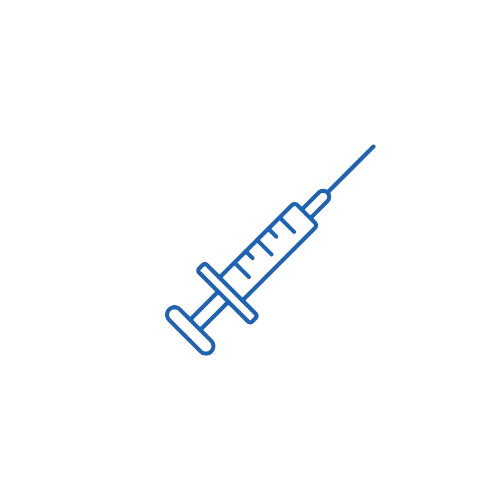Aztreonam
Allopathic
Indications
- Approved Indications:
- Moderate to severe infections caused by susceptible aerobic gram-negative bacteria.
- Urinary tract infections (cystitis, pyelonephritis).
- Lower respiratory tract infections, including pneumonia.
- Intra-abdominal infections, including peritonitis.
- Skin and soft tissue infections.
- Gynecological infections such as pelvic inflammatory disease.
- Septicemia due to susceptible gram-negative bacteria.
- Bone and joint infections.
- Meningitis caused by susceptible organisms.
- Off-label and Clinically Accepted Uses:
- Pulmonary infections in cystic fibrosis patients caused by Pseudomonas aeruginosa.
- Surgical prophylaxis in high-risk procedures.
- Treatment of infections in penicillin-allergic patients due to minimal cross-reactivity.
Dosage & Administration
Route: Intravenous (IV) or intramuscular (IM) injection.
Adults:
- Typical dosing ranges from 1 to 2 grams every 8 to 12 hours, adjusted according to infection severity and clinical response.
- For severe infections, 2 grams IV every 8 hours may be used.
Pediatrics:
- Dosage based on body weight: generally 30 to 50 mg/kg every 8 hours, maximum daily dose not to exceed adult doses.
- Neonates and infants require careful dosing adjustments and close monitoring.
Elderly:
- Use standard adult doses; monitor renal function closely.
Renal Impairment:
- Dosage adjustments necessary for creatinine clearance <30 mL/min.
- Increased dosing intervals or reduced doses advised to avoid accumulation.
Administration Notes:
- IV infusion is typically diluted in compatible fluids and administered over approximately 30 minutes.
- IM injections should be given deep into large muscles.
- Reconstituted solutions should be used promptly to maintain potency and sterility.
Mechanism of Action (MOA)
Aztreonam is a monobactam beta-lactam antibiotic that inhibits bacterial cell wall synthesis. It binds selectively to penicillin-binding protein 3 (PBP-3) of susceptible aerobic gram-negative bacteria, disrupting peptidoglycan cross-linking essential for cell wall structural integrity. This results in cell wall weakening, bacterial lysis, and cell death. Aztreonam is active predominantly against aerobic gram-negative bacilli, including Pseudomonas aeruginosa, but lacks significant activity against gram-positive or anaerobic bacteria.
Pharmacokinetics
- Absorption:
Not absorbed orally; administered parenterally (IV or IM). - Distribution:
Widely distributed throughout body tissues and fluids, including bile, sputum, urine, and cerebrospinal fluid (when meninges are inflamed).
Volume of distribution approximates extracellular fluid volume. - Metabolism:
Minimal hepatic metabolism; largely excreted unchanged. - Elimination Half-life:
Approximately 1.7 hours in patients with normal renal function. - Excretion:
Primarily eliminated unchanged via renal glomerular filtration.
Pregnancy Category & Lactation
- Pregnancy:
FDA Category B — animal studies have not demonstrated fetal risk; however, adequate and well-controlled studies in pregnant women are lacking. Use only if clearly needed. - Lactation:
Excreted in breast milk in small amounts; use with caution during breastfeeding.
Therapeutic Class
- Primary Therapeutic Class: Antibiotic
- Subclass: Monobactam beta-lactam antibiotic
Contraindications
- Known hypersensitivity to aztreonam or any component of the formulation.
- Use with caution in patients with known hypersensitivity to other beta-lactam antibiotics due to rare potential cross-reactivity.
Warnings & Precautions
- Hypersensitivity reactions, including anaphylaxis and angioedema, may occur; discontinue immediately if such reactions develop.
- Prolonged use may lead to superinfection, including fungal infections.
- Renal function should be monitored during therapy, with dose adjustments as necessary.
- Caution advised in neonates and infants due to immature renal clearance.
Side Effects
Common:
- Injection site reactions (pain, inflammation).
- Rash.
- Diarrhea.
- Nausea, vomiting.
Serious but Rare:
- Severe allergic reactions (anaphylaxis).
- Clostridioides difficile-associated diarrhea.
- Transient elevations in liver enzymes.
- Hematologic abnormalities such as neutropenia or thrombocytopenia.
Drug Interactions
- No significant direct interactions reported.
- Concurrent nephrotoxic drugs (e.g., aminoglycosides, vancomycin) may increase risk of kidney damage; monitor renal function closely.
- Probenecid may reduce renal clearance of aztreonam, increasing plasma concentrations.
Recent Updates or Guidelines
- Remains a preferred antibiotic for gram-negative infections in penicillin-allergic patients.
- Increasing bacterial resistance requires susceptibility testing prior to therapy.
- Combination therapy may be recommended for multi-drug resistant infections.
Storage Conditions
- Store powder and reconstituted solutions at 20°C to 25°C (68°F to 77°F).
- Protect from light and moisture.
- After reconstitution, use within recommended timeframe (typically 24 hours refrigerated).
- Do not freeze.
